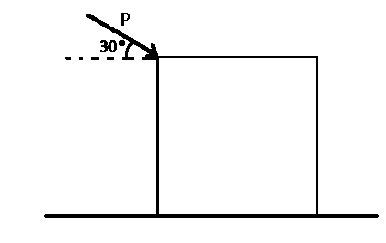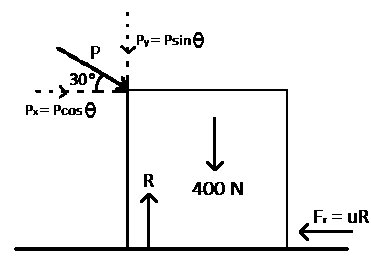
Physics Questions and Answers
If you want to learn more about the nature and properties of matter and energy or you're simply preparing for a Physics exam, these Physics past questions and answers are ideal for you.

If you want to learn more about the nature and properties of matter and energy or you're simply preparing for a Physics exam, these Physics past questions and answers are ideal for you.
5.23 m
6.42 m
4.87 m
7.26 m
Correct answer is A
Let the original length L=xm
;New length =( x -3 ) m
\(T_1\) = 5.77s; \(T_2\) = 4.60s,
\(T^2\) α L
⇒\(T_2) = kL where K is constant
⇒K = \(\frac{T^2_1}{L_1}\) = \(\frac{T^2_2}{L_2}\)
⇒\(\frac{5.77^2}{x}\) = \(\frac{4.60^2}{x-3}\)
⇒ \(\frac{33.29}{x}\) = \(\frac{4.60^2}{x-3}\)
⇒ 33.29(x-3) = 21.16x
⇒ 33.29x - 99.87 =21.16x
⇒12.13x = 99.87
;x =\(\frac{99.87}{12.13}\) = 8.23m
New length of the pendulum
=x-3 = 8.23-3
=5.23m
\(5.09×10^{15}\)Hz
\(5.09×10^{14}\) Hz
\(1.77×10^{15}\) Hz
\(1.77×10^{14}\) Hz
Correct answer is B
n=1.458, c=\(3.00 ×10^8 ms^-1\) ,λo = 589nm; f=?
Speed of light in a medium (v)=\(\frac{c}{n}\) where n is the refractive index of the medium
⇒λn=\(\frac{589}{1.458}\) = 404nm
v=fλ
⇒f=\(\frac{v}{λ}\)
=\(\frac{2.06×10^8}{404×10^-9}\) \(1nano=10^{-9}\)
∴f=\(5.09×10^{14}\) Hz

0.19
0.24
0.40
0.22
Correct answer is A

W = 400 N; P = 100 N; θ = 30o; μ = ?
Frictional force (Fr) = μR (where R is the normal reaction)
The forces acting along the horizontal direction are Fr and Px
∴ Pcos 30° - Fr = ma (Pcos 30° is acting in the +ve x-axis while Fr in the -ve x-axis)
⇒ 100cos 30° - μR = ma
Since the box is moving at constant speed, its acceleration is zero
⇒ 100cos 30° - μR = 0
⇒ 100cos 30o = μR ----- (i)
The forces acting in the vertical direction are W, Py and R
∴ R - Psin 30° - W = 0 (R is acting upward (+ve) while Py and W are acting downward (-ve) and they are at equilibrium)
⇒ R - 100sin 30° - 400 = 0
⇒ R = 100sin 30° + 400
⇒ R = 50 + 400 = 450 N
From equation (i)
⇒ 100cos 30° = 450μ
⇒μ=100cos30°
N = \(\frac{100cos30°}{450}\)
= μ = 0.19
Pyrometer thermometer
Platinum resistance thermometer
Thermocouple thermometer
Constant pressure gas thermometer
Correct answer is A
A pyrometer is a type of remote-sensing thermometer used to measure the temperature of a surface. It does this by measuring the thermal radiation or infrared energy being emitted from the object. Therefore, a pyrometer thermometer measures temperature from the thermal radiation emitted by objects.
6680 J
1680 J
7520 J
7940 J
Correct answer is D
Quantity of heat required to raise the temperature of the ice cube from \(-10^oC\) to \(0^oC\)
⇒H=mc►ø = 0.02 × 2100 × 0 -(-10)
⇒ H = 0.02 × 2100 × (0 + 10) = 0.02 × 2100 × 10
⇒ H = 420 J
quantity of heat required to melt ice at \(0^oC\)
⇒ H = mL = 0.02 × 3.34 × \(10^5\)
⇒H=6680 j
Quantity of heat required to raise the temperature of the melted ice cube (water) from \(0^oC\) to \(-10^oC\)
⇒H=mc►ø = 0.02 × 4200 × (10-0)
⇒H = 0.02 × 4200 × 10
⇒H = 840j
;420 + 6680 + 840 = 7940 j